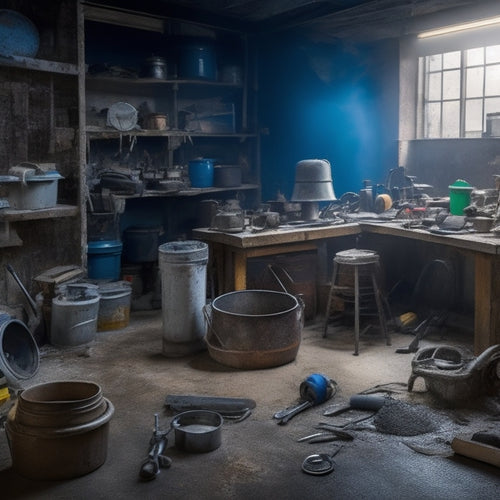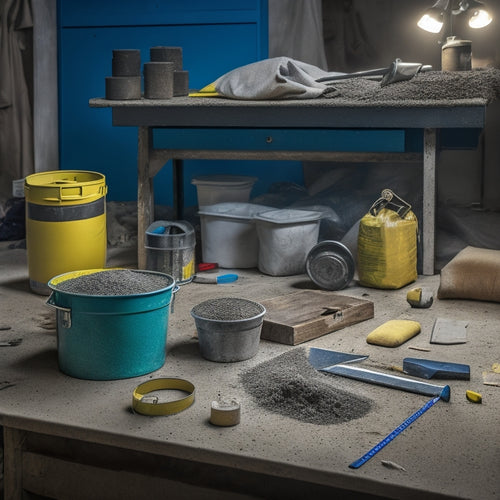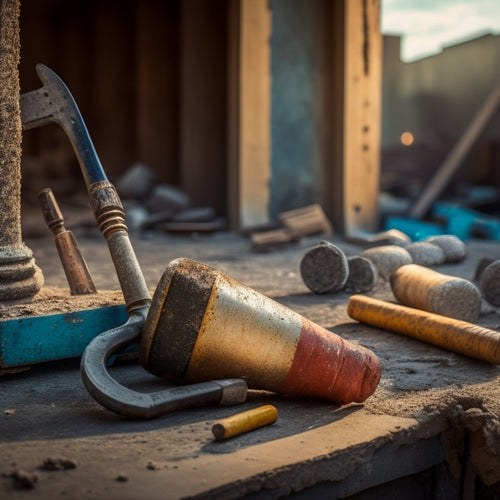
Top 3 DIY Finishing Tools for Premixed Concrete
Share
When working with premixed concrete, you'll need three essential DIY finishing tools to achieve a professional-looking finish: a tamping tool to remove air pockets and excess water, an edger to define crisp lines and joints, and a float to smooth out imperfections. With a tamping tool, you'll guarantee a smooth surface by removing excess water and air pockets. An edger will help you create sharp, well-defined lines, while a float will flatten and smooth out imperfections. Mastering these tools and techniques will get you one step closer to a flawless concrete finish, and with the right guidance, you'll be well on your way to achieving stunning results.
Key Takeaways
• Essential DIY finishing tools for premixed concrete include a tamping tool, edger, and float for a smooth, professional-looking finish.
• A tamping tool removes air pockets and excess water, ensuring a strong and durable concrete surface.
• An edger defines edges and joints, creating sharp, well-defined lines when used during the early setting stage.
• A float is vital for achieving a smooth, even finish, and should be used in long, sweeping strokes with gentle to moderate pressure.
• Mastering techniques and using these tools correctly is crucial for a high-quality, DIY concrete finish.
Tamping Tool for Smooth Finishes
When working with premixed concrete, using a tamping tool is essential for achieving a smooth, even finish by removing air pockets and excess water.
You'll want to invest in a high-quality tamping tool, as it's an important step in surface preparation. Proper tamping techniques involve holding the tool at a 45-degree angle and applying gentle to moderate pressure, depending on the concrete's consistency. This helps to compact the mixture and eliminate air pockets that can lead to an uneven finish.
As you tamp, focus on working in small sections, about 2-3 square feet at a time. This allows you to maintain control and guarantee a consistent finish.
When tamping, pay attention to the tool's vibration; it should feel smooth and even. If you notice any resistance or hear a hollow sound, it may indicate an air pocket that needs to be addressed.
Edger for Crisp Concrete Lines
To create crisp, clean lines in your premixed concrete, you'll need an edger, a tool specifically designed to define the edges and joints of your concrete surface. This tool is vital for achieving professional-looking concrete aesthetics.
By mastering edger techniques, you can create sharp, well-defined lines that add visual appeal to your concrete projects.
When using an edger, it's important to hold the tool at a 45-degree angle and apply gentle to moderate pressure, depending on the type of concrete and the desired finish.
Start at one end of the joint or edge and work your way along, using smooth, consistent strokes to remove excess concrete and create a clean, defined line.
Remember to always use the edger when the concrete is still in its early stages of setting, as this will guarantee a more precise and defined edge.
Float for Even Surface Finishing
How do you achieve a smooth, even finish on your premixed concrete surface? The answer lies in mastering float techniques, a vital step in surface preparation.
A float is a long, flat tool used to flatten and smooth out the concrete, removing any imperfections or irregularities. To get started, hold the float at a 45-degree angle and press it firmly onto the surface, applying gentle to moderate pressure.
Move the float in long, sweeping strokes, overlapping each pass to guarantee complete coverage. As you work, maintain a consistent pace and pressure to avoid creating unevenness.
Be sure to keep the float clean and free of debris, as any dirt or aggregate can scratch the surface. By employing these float techniques, you'll be able to achieve a uniform, even finish that's perfect for further finishing treatments, such as troweling or sealing.
With practice, you'll develop the skills to produce a professional-looking finish that will elevate your premixed concrete projects to the next level.
Frequently Asked Questions
Can I Use a Tamping Tool on Freshly Poured Concrete?
When you're working with freshly poured concrete, it's crucial to exercise caution with your tamping technique.
You can use a tamping tool, but avoid over-tamping, which can lead to surface defects. Instead, use gentle, even strokes to remove air pockets and guarantee proper consolidation.
How Do I Clean My Edger After Finishing a Project?
After finishing a project, you'll want to clean your edger thoroughly to maintain its performance and extend its lifespan.
Start by removing any excess concrete with a stiff brush or scraper.
Then, soak the edger in warm soapy water, and use a soft-bristled brush to scrub away any stubborn residue.
Rinse thoroughly and dry with a clean towel.
Regular cleaning techniques like these guarantee peak tool maintenance, keeping your edger in top condition for your next project.
What Safety Gear Should I Wear When Working With Concrete?
When working with concrete, you'll need to prioritize concrete safety by wearing the right protective gear.
You'll want to don a pair of durable gloves to shield your hands from abrasion and cement burns.
Safety glasses or goggles will protect your eyes from flying debris and chemical splashes.
A dust mask or respirator will prevent inhalation of silica particles and other airborne contaminants.
Can I Rent DIY Finishing Tools or Do I Need to Buy?
When it comes to acquiring DIY finishing tools, you've got options.
Renting tools can be a cost-effective solution if you're working on a small project or don't plan on using them frequently.
However, if you're planning multiple concrete projects or want the convenience of having tools on hand, buying might be the way to go.
Consider your project scope, budget, and long-term needs before deciding between renting and buying.
How Long Does It Take to Master DIY Concrete Finishing?
Mastering DIY concrete finishing techniques takes time and dedication.
You'll need to invest several weeks to months in practicing and refining your skills.
Start by learning basic techniques, such as troweling and edging.
As you progress, focus on mastering more advanced skills, like stamping and texturing.
With consistent practice, you'll develop muscle memory and confidence.
Be patient, though - it can take up to a year or more to truly master concrete skills and achieve professional-level results.
Conclusion
You've managed to mix and pour the premixed concrete, and now it's time to add the finishing touches.
Ironically, the most essential steps in concrete finishing are often overlooked, leading to subpar results.
But not you! With the top 3 DIY finishing tools - tamping tool, edger, and float - you'll achieve a professional-grade finish that will make others wonder if you hired a pro.
Your hard work will pay off, and that concrete slab will be the envy of the neighborhood.
Related Posts
-

7 Tools to Fix Damaged Concrete Floors
You're about to tackle that damaged concrete floor, and the right tools are essential for a successful repair. Start ...
-

Top Mixing Tools for DIY Concrete Block Laying
When it comes to DIY concrete block laying, the right mixing tools are vital for a strong and durable structure. You'...
-

5 Tips for Splitting Concrete With Second-Hand Tools
When splitting concrete with second-hand tools, you'll need to be strategic to avoid wasting time, money, and putting...


